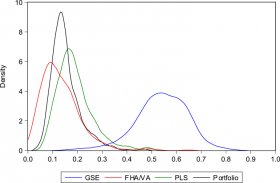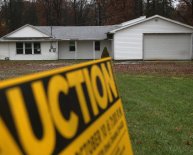
Government-backed mortgages
 The United Sates government has a long history of involvement in mortgage finance. During the 1930s, the government created the Federal Home Loan Banks (FHLB), the Federal Housing Administration (FHA), and the Federal National Mortgage Association (Fannie Mae). Since then, these programs grown in size and scope, and the government has introduced additional programs including the Federal Home Loan Mortgage Corporation (Freddie Mac) and the Government National Mortgage Association (Ginnie Mae).
The United Sates government has a long history of involvement in mortgage finance. During the 1930s, the government created the Federal Home Loan Banks (FHLB), the Federal Housing Administration (FHA), and the Federal National Mortgage Association (Fannie Mae). Since then, these programs grown in size and scope, and the government has introduced additional programs including the Federal Home Loan Mortgage Corporation (Freddie Mac) and the Government National Mortgage Association (Ginnie Mae).
During the most recent financial crisis, most of the government focus concerning mortgage finance was on mortgage debt relief and mortgage refinancing for households that had experienced large declines in house values. The housing programs created during the Great Depression were taken as background fixtures during the Great Recession. As a result, the Great Recession provides an opportunity to empirically assess the impacts of the Great Depression housing programs during significant economic downturns. Most of these programs were created with the objective of limiting the damage to households during the Great Depression and speeding the economic recovery. We address the empirical question: Did they perform this role during the Great Recession?
We characterize the mortgage market structure of a county via four mortgage origination channels: the proportion of mortgages that flow into bank portfolios (portfolio share), the proportion that flow into private-label securities (PLS share), the proportion that are securitized by Fannie Mae or Freddie Mac (GSE share), and the proportion that are insured by the FHA or VA (FHA/VA share).
The frequency distributions shown in figure 1 demonstrate the significant variation in the county distributions of government program use prior to the financial crisis. GSE securitization ranged from nearly 25 percent to over 75 percent of the proportion of originations in a county, where use of the FHA was much lower, ranging from close to zero to over 35 percent (top two panels). The share of mortgage originations flowing into bank portfolios ranged from 6 percent to 33 percent (bottom left). PLS, even at their heyday prior to the financial crisis, accounted for a relatively smaller proportion of the flow of mortgage originations from a county, ranging from 8 percent to just under 45 percent (bottom right).
| Figure 1: Mortgage Market Share Density Functions |
|---|
In this note, we estimate how the intensity of GSE, FHA, PLS, and portfolio exposures influence the state of the real economy across counties. However, the use of such securitization outlets and the prevalent of bank portfolio alternatives may not be independent from the same conditions that create relatively high economic performance in a county. Thus, we control for the "propensity" of particular counties to use or select into various mortgage financing alternatives, conditional on economic fundamentals such as average incomes, house prices, and unemployment rates. By controlling for counties' propensities to select into GSE, FHA, PLS, and portfolio treatments, we can directly estimate the effect of financing alternatives on economic activity within a county.
Our identification strategy relies on the variation in government involvement in mortgage markets across counties. Counties with significant government involvement are subject to underwriting and credit risk pricing standards that are set at a national level. In contrast, counties with little government involvement are subject to underwriting and credit risk pricing standards set more by local banks, thrifts, mortgage banks, and private-sector mortgage securitization conduits (whose underwriting standards may or may not be set at the national level, and whose underwriting standards are likely more varied and responsive to current market conditions).
We envision each county containing a set of mortgage financing structures that changes only slowly over time and reflects the economic characteristics of the population that lives in those counties. As the securitization outlets are provided by national entities, their relative usage in a county reflects the underlying county characteristics. Thus, we model the extent of banks' participation in securitization outlets on the basis of observed census characteristics that are unrelated to the availability of the securitization outlets.

















